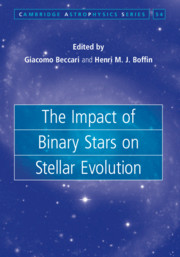Book contents
- Frontmatter
- Contents
- List of Contributors
- Foreword
- Introduction
- 1 The Zoo of Binary Stars
- 2 Statistics of Binary and Multiple Stars
- 3 Gaia and LSST: Their Importance in Binary Star Research
- 4 Population Synthesis of Binary Stars
- 5 Low- and Intermediate-Mass Star Evolution: Open Problems
- 6 The Symbiotic Stars
- 7 Binary Post-AGB Stars as Tracers of Stellar Evolution
- 8 The Importance of Binarity in the Formation and Evolution of Planetary Nebulae
- 9 Massive Star Evolution: Binaries as Two Single Stars
- 10 Binarity at High Masses
- 11 Luminous Blue Variables: Their Formation and Instability in the Context of Binary Interactions
- 12 Type Ia Supernovae: Where Are They Coming From and Where Will They Lead Us?
- 13 Binary Interactions and Gamma-Ray Bursts
- 14 Binaries as Sources of Gravitational Waves
- 15 The Impact of Binaries on the Stellar Initial Mass Function
- 16 The Formation of Binary Stars: Insights from Theory and Observation
- 17 The Maxwell’s Demon of Star Clusters
- 18 Alternative Stellar Evolution Pathways
- 19 Clocks and Scales: Playing with the Physics of Blue Stragglers
- 20 Binaries at Very Low Metallicity
- 21 Population and Spectral Synthesis: It Doesn’t Work without Binaries
- Index
15 - The Impact of Binaries on the Stellar Initial Mass Function
Published online by Cambridge University Press: 05 April 2019
- Frontmatter
- Contents
- List of Contributors
- Foreword
- Introduction
- 1 The Zoo of Binary Stars
- 2 Statistics of Binary and Multiple Stars
- 3 Gaia and LSST: Their Importance in Binary Star Research
- 4 Population Synthesis of Binary Stars
- 5 Low- and Intermediate-Mass Star Evolution: Open Problems
- 6 The Symbiotic Stars
- 7 Binary Post-AGB Stars as Tracers of Stellar Evolution
- 8 The Importance of Binarity in the Formation and Evolution of Planetary Nebulae
- 9 Massive Star Evolution: Binaries as Two Single Stars
- 10 Binarity at High Masses
- 11 Luminous Blue Variables: Their Formation and Instability in the Context of Binary Interactions
- 12 Type Ia Supernovae: Where Are They Coming From and Where Will They Lead Us?
- 13 Binary Interactions and Gamma-Ray Bursts
- 14 Binaries as Sources of Gravitational Waves
- 15 The Impact of Binaries on the Stellar Initial Mass Function
- 16 The Formation of Binary Stars: Insights from Theory and Observation
- 17 The Maxwell’s Demon of Star Clusters
- 18 Alternative Stellar Evolution Pathways
- 19 Clocks and Scales: Playing with the Physics of Blue Stragglers
- 20 Binaries at Very Low Metallicity
- 21 Population and Spectral Synthesis: It Doesn’t Work without Binaries
- Index
Summary
The stellar Initial Mass Function (IMF) can be conveniently represented as a canonical two-part power law function and is largely invariant for star formation regions evident in the Local Group of galaxies. The lack of massive stars in regions of low star formation density and other evidence imply that the IMF is not a probability density distribution function, but is instead closer to an optimal density distribution function. Binary stars and stellar dynamics have a very significant influence on the counts of low-mass stars and need to be corrected for. This chapter offers a review of how recent advancements in the measurement of the IMF from detailed star counts in different environments (e.g., young massive clusters, globular clusters, elliptical galaxies and ultrafaint dwarf galaxies), properly interpreted via detailed numerical models, indicate that the environmental conditions and metallicity both have an impact on the shape of the IMF.
Keywords
Information
- Type
- Chapter
- Information
- The Impact of Binary Stars on Stellar Evolution , pp. 208 - 224Publisher: Cambridge University PressPrint publication year: 2019
Accessibility standard: Unknown
Why this information is here
This section outlines the accessibility features of this content - including support for screen readers, full keyboard navigation and high-contrast display options. This may not be relevant for you.Accessibility Information
- 2
- Cited by
